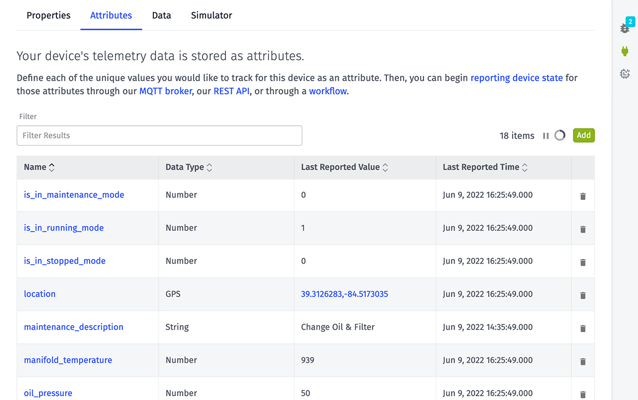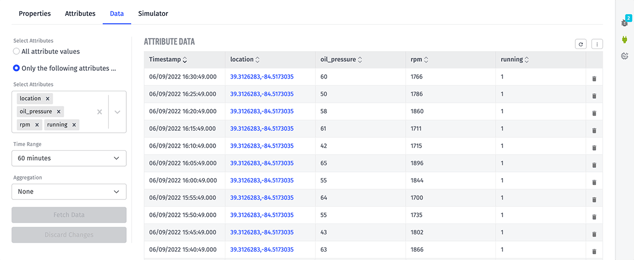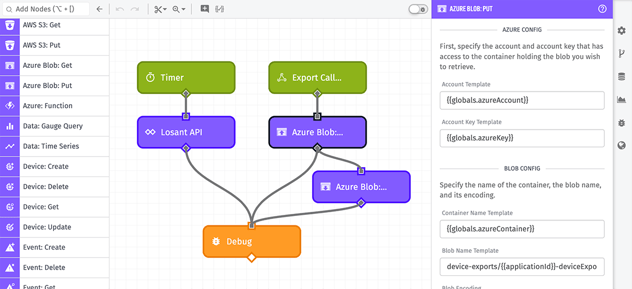Today’s platform update brings some improvements to our device management interface. We’re also introducing a couple of new cloud storage workflow nodes, tools for resellers to manage their sandbox users, and a variety of smaller improvements.
Device Data & Attribute UI Updates
First, we’ve revamped our Device Attribute interface to make it easier to parse and find all of the telemetry values being reported for a given device. Gone is the top-to-bottom list of device attributes in collapsible panels; instead, the attributes are now presented in a sortable table, with the option to view an individual attribute’s meta tags and description — and in the case of system devices, their reporting characteristics — behind a detail modal.

More importantly, the table also includes the last reported value (with timestamp) for each of the device’s attributes, including links to download blobs and view GPS data on a map.
We’ve also added a new "Data" tab to the device interface, which acts as a simplified Data Explorer scoped to the device. Users can request state reports for relative time ranges or for specific start and end times; for all attributes or just a selection of a few; and for any of our supported data aggregations. You can also export or delete the presented data, including deleting individual data points.

These changes not only make it easier to debug device activity early in the application development process, but also to digest the properties of mature, production devices. Internally, we’ve been very happy with these updates and we expect our users will be as well.
Azure Blob Storage Nodes
Expanding on our integrations with the major cloud vendor services, we’ve added the Azure Blob: Get and Azure Blob: Put Nodes in this release. This allows Losant users who utilize Azure Blob Storage to read and write to their containers through the workflow engine.
For example, our Stream Exports to AWS S3 template can easily be imported and edited to instead send device exports and notebook outputs to an Azure container.

The Azure Blob Nodes join the AWS S3 Get and Put Nodes, and the FTP Get and Put Nodes, as ways of integrating third-party storage options with your Losant applications.
Instance Sandbox Management
Finally, resellers and enterprise users of Losant’s Instance Manager now have the ability to manage sandbox accounts created under their instance. Instance administrators can view a user’s account security status; check their monthly resource usage; and mark the user for deletion.
This gives instance administrators many of the same tools that Losant uses to help debug issues, manage platform resources, and deal with malicious actors.
Other Updates
As always, this release comes with a number of smaller feature improvements, including:
- The JWT: Create Node now allows for setting custom headers on the generated token. This allows for passing additional header parameters, such as the Key ID (
kid). - Edge Workflow initial payloads now include the device’s version of the Gateway Edge Agent (starting with GEA v1.31.0). This enables a use case where the device can send a request to the Docker Hub API and compare its version to the most recent version of losant/edge-agent, optionally taking action if the device is out of date.
- The Workflow Trigger Node is now available in Experience Workflows. This allows for passing separate processes initiated by Experience Endpoint requests to Application Workflows, freeing up your application’s Experience Workflow concurrency slots to handle incoming requests.
- Organization tags are now included in Instance Usage Reports. This helps resellers streamline monthly billing processes by including that meta information alongside an organization’s resource counts and payload consumption.
- We’ve been steadily adding callback URL support to our asynchronous API operations, and this release includes another endpoint to receive the update: Data Table Rows: Export.
What’s Next?
With every new release, we listen to your feedback. By combining your suggestions with our roadmap, we can continue to improve the platform while maintaining its ease of use. Let us know what you think in the Losant Forums.
